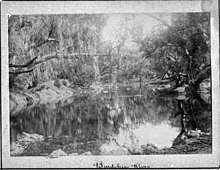Irwin's turtle
Irwin's turtle (Elseya irwini) is a rare species of freshwater turtle in the family Chelidae. The species is endemic to Australia, originating from the lower region of the Burdekin River area.
| Irwin's turtle | |
|---|---|
.jpg) | |
| Scientific classification | |
| Kingdom: | Animalia |
| Phylum: | Chordata |
| Class: | Reptilia |
| Order: | Testudines |
| Suborder: | Pleurodira |
| Family: | Chelidae |
| Genus: | Elseya |
| Subgenus: | Pelocomastes |
| Species: | E. irwini |
| Binomial name | |
| Elseya irwini Cann, 1997[1] | |
Discovery
Steve Irwin and his father Bob Irwin, spotted a specimen of E. irwini on a crocodile catching trip on the Burdekin river in 1990. They had never seen it before. "Co-discoverer", famed zoologist and TV personality, Steve Irwin took pictures and sent them to turtle-expert John Cann who verified that it was indeed a new species. [2] This new species was then named after the father and son duo.
Description
The female of the species E. irwini has a pale head with a yellowish horny sheath on the crown.[3] The pale color present in the female of this species is due to a lack of multiple pigments which affect essentially all parts of the body. [4] These individuals are known for their sturdy skull which is supported by a narrow muscle called the pterygoid, creating a shielding for the skull and providing normal jaw functions.[5]

Respiration
E. irwini, like some other turtles,[6] can breathe underwater by taking water into its cloaca. The cloaca is a cavity at the end of the digestive tract containing a chamber with gill-like structures which allow for the diffusion of oxygen .[7] Without this structure this species of turtle would not be able to stay under water for long periods of time. Like most reptiles, Irwin's turtle needs to live in a source of water that is plentiful with oxygen. If the water has low oxygen levels or is filled with contaminants, the turtle has a lower chance of survival.
Possibility of extinction
The Burdekin River, where this species is originated, has become the source of the decline in water quality in surrounding areas. Bad water quality makes it hard for this species to survive and reproduce. To fix this occurring issue there is consideration for dam reconstruction. This project includes building/raising the walls of the dam by 2 meters. If this change occurs the water levels at different areas of the river will likely have flooding, although this sounds unfit these changes are a more suitable habitat for this species to survive. [8]
See also
- List of organisms named after celebrities
References
- Cann J (1997). "Irwin's Turtle, Elseya irwini sp. nov.". Monitor – J. Victorian Herp. Soc. 9 (1): 36-40.
- Beolens, Bo; Watkins, Michael; Grayson, Michael (2011). The Eponym Dictionary of Reptiles. Baltimore: Johns Hopkins University Press. xiii + 296 pp. ISBN 978-1-4214-0135-5. (Elseya irwini, p. 130).
- http://www.jcu.edu.au/school/tbiol/zoology/herp/Elseyalatisternum.PDF#search=%22elseya%20irwini%22
- Turner, Grant S. (2011). "Hypomelanism in Irwin's Turtle, Elseya irwini, from the Johnstone River, North Queensland, Australia". Chelonian Conservation and Biology. 10 (2): 275–281. doi:10.2744/CCB-0851.1. ISSN 1071-8443.
- Limpus, Colin J.; Georges, Arthur; Thomson, Scott (May 1, 2006). "A New Species of Freshwater Turtle in the Genus Elseya (Testudines: Chelidae) from Central Coastal Queensland, Australia". Chelonian Conservation and Biology. 5 (1): 74–86. doi:10.2744/1071-8443(2006)5[74:ANSOFT]2.0.CO;2. ISSN 1071-8443.
- Rheodytes leukops — Fitzroy River Turtle, Fitzroy Tortoise, Fitzroy Turtle
- "Cloaca - Definition, Function and Quiz". Biology Dictionary. 2017-07-04. Retrieved 2019-03-28.
- Beeton, Profesdsor Robert (2009). "Advice to the minister for the environment, heritage and the arts from the threatened species of scientific committee" (PDF). Biochemical and Biophysical Research Communications.
External links
| Wikispecies has information related to Elseya irwini |